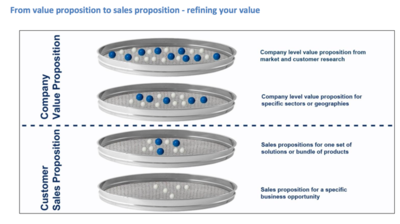Value proposition - true value
Many companies face a fundamental problem: there is a sizeable and growing gap between what they offer and what their customers actually value. This value gap leads to lost sales, lower profits, commoditisation, failure to innovate and the wrong organisational structure potentially employing the wrong people. It can even threaten the company's very survival.
Why don't your customers value what you offer?
Companies face four key issues that stop them giving customers what they value:
1.They misunderstand what a value proposition is, so they cannot create one that meets their customers' needs

2.They only partially comprehend how customers perceive value and how to uncover their unmet needs
3.They often use an outdated value proposition that doesn't actually work for them today
4.Without the benefit of an effective company-wide value proposition, sales teams are forced to create sales propositions in a vacuum, ensuring they fail tocommunicate effectively the value the company delivers.
The default value proposition that many companies still use:
"We'll give you a little advice, help and service, in exchange for slightly better margins."
Ref: Adapted from Professor Neil RackhamTen years ago, this would have satisfied the majority of customers.
Only a minority wanted businesses to sell to them transactionally. Similarly, most customers were not looking for relational or consultative selling.
Transactional selling works when customers know what they want to buy, products and services are standardised, customers are price-driven and a business simply communicates value to the customer. Often you don't need expensive on-the-road sales people to do this.
Transactional selling can increasingly be managed through online channels for simple purchases or with excellent telephone-based internal sales or customer service staff, if a higher level of interaction is needed.
Consultative or relational selling is needed when customers don't know what they want to buy and need help to define the right solution. Products and services are customised to achieve the customer's desired outcome, allowing the business to co-create value with the customer.
Adapted value proposition now looks like this:
"We'll use our expertise to bring you insights, solve your problems and co-create custom solutions with you, for which we'll charge you a premium."
The value propositions shown above are generalisations. To be effective, you need to create your own value propositions, which capture precisely what your customers want.
To learn more download Harnessing the Truth article from here.
) Author:Danielle MacInnis
Author:Danielle MacInnis| Tags:Customer Centric MarketingValue Proposition |
Post comment




